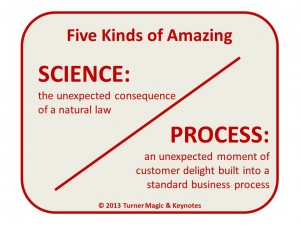Five Kinds of Amazing, Part 2: Science
In a previous article we outlined the framework of the Five Kinds of Amazing model for understanding what makes an experience “amazing” for an audience. Later, we examined the first category of such experiences, those based on overt demonstrations of talent or deep expertise. Now we’ll turn our attention to the second category of amazing experiences: Science. Amazing experiences in this category are essentially an encounter with the unexpected consequences of a natural law.
Arthur C. Clarke, the author of 2001: A Space Odyssey and other science fiction novels, famously wrote that “Any sufficiently advanced technology is indistinguishable from magic.” If you think about this statement, you’ll realize that it concisely communicates a few different interesting ideas.
- People develop expectations about how the world operates based on their most common experiences; these experiences are driven by the prevailing culture and technological environment.
- There are completely natural laws that, under certain circumstances or in certain combinations, will produce counter-intuitive results.
- If you can create circumstances or devices that exploit those less-familiar natural laws and frame the results in a desired dramatic context, you can create what appear on the surface to be impossible experiences. That experience will be interpreted as “amazing.”

Outside of digital technology, there are other fundamental scientific phenomena that still seem magical. The moon constantly orbits the earth, but it doesn’t always line up just right to produce an eclipse. When it does, that experience is unexpected – even magical in some cultures – despite being just a natural result of the physical law.
Likewise, many of us have been amazed by unusual physics demonstrations such as refracting a laser beam inside a stream of water, spinning on a stool with a bicycle wheel due to the conservation of angular momentum, or the shattering of a banana frozen in liquid nitrogen. Some optical illusions exploit the physiology of our eyes, or the psychology of our attention and perception, in order to produce unusual visual experiences.
These experiences are amazing not because any physical laws are being broken, but because they are being applied in unexpected ways and lead to unexpected results.
[gn_spacer size=”50″]
Process and Brand Engagement
So how can we harness the concept of “amazing science” and apply it to our own businesses and brands?
When it comes to applying this principle to business and brand engagement, the counterpart to “Science” is “Process.” Your processes are your enterprise’s natural laws, determining how and when things happen. Your action and reaction are determined by your business processes, whether they are documented or not.
Look at the processes in your business. How are sales made? How are orders taken? How are invoices sent? How do you communicate with your customers and your employees? Which process in your business do your customers experience the most? Which process do you get complaints about?
Look inside that process for a way to hide an unexpected moment or reward, like an “Easter egg” in a piece of software. Maybe every customer will experience it, or maybe only some of them will. But every process of your business is an opportunity to deliver an unexpected outcome to the audience, and if you want to be amazing in their eyes then you have to take advantage of at least some of those opportunities.
How do your processes lead to unexpectedly delightful experiences for your audience?






